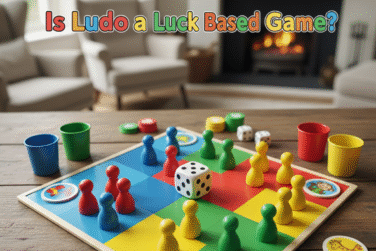Ludo, which is one among the many different types of board games, is more than just a way to pass the time—it’s a shared experience, a nostalgic connection to simpler days, and a strategic battlefield that continues to captivate players around the world. From school lunch breaks to family gatherings and weekend game nights, Ludo has secured its place as the undisputed king of board games. Its colorful design and simple rules make it accessible to all ages, yet its depth keeps even the most seasoned players engaged. But Ludo is more than just rolling dice and moving tokens—it’s a game of timing, tactics, and smart decisions. In this comprehensive guide, we’ll explore everything you need to know about Ludo, including its rich history, official rules, winning strategies, and expert tips to help you master the board and outplay your opponents.
History and Origins of Ludo
The story of Ludo dates back to 6th-century India, where its ancestor, Pachisi, was played by royalty. The game is believed to have originated in northern India, and evidence of it can be found in ancient cave paintings and manuscripts. It was a complex game played on a cross-shaped board with cowrie shells used as dice.
In 1896, Alfred Collier, a British citizen, modified Pachisi to make it more accessible and less time-consuming. He introduced a cubic die and simplified the rules. This version was patented as “Ludo” in England, and its popularity spread rapidly across the British Empire.
Evolution Over the Centuries
While traditional Pachisi had a more elaborate structure and was often team-based, Ludo was adapted for simpler household play. The new format made the game more inclusive and faster-paced, allowing children and adults alike to enjoy it.
Cultural Significance
Ludo transcended boundaries. In many Asian and African countries, it became a staple of childhood. In Western countries, it became part of classic board game sets. Its enduring charm lies in its simplicity and the excitement generated from something as unpredictable as a dice roll.
Understanding the Ludo Board Game
A typical Ludo board is cross-shaped, divided into four colored sections—Red, Blue, Green, and Yellow—with each representing a player. The center of the board is the home area where all players race to reach. Each player has a “home base,” a “starting square,” and a “home column” specific to their color.
Board Elements in Detail
- Home Base: This is where all four of a player’s tokens begin. Tokens can’t move from here until a six is rolled.
- Starting Square: The entry point onto the board from the home base.
- Main Track: A circuit of 52 squares around the board that tokens must travel.
- Home Column: A 6-square path leading directly to the center (only accessible to a player’s own tokens).
- Safe Spots: Usually marked with stars or a distinct icon, these are landing zones where tokens cannot be captured.
Dice Mechanics
Ludo uses a single six-sided die. Each roll determines how many spaces a token can move. A six offers a bonus roll, and players must use all moves they’re entitled to strategically.
How to Play Ludo Board Game?
Ludo can be played with 2, 3, or 4 players. The aim is to move all four of your tokens around the board and into the center (home) before your opponents. It’s a mix of luck and logic, and no two games are ever the same.
Game Setup
- Place the board on a flat surface.
- Each player chooses a color and places their four tokens in the matching home base.
- Players take turns rolling the die; the one who rolls the highest goes first.
Step-by-Step Gameplay
- Entering the Board: A player must roll a six to move a token from their home base onto the starting square.
- Rolling a Six: Allows the player to roll again. Three consecutive sixes result in a lost turn.
- Moving Around the Board: Tokens move clockwise along the path. You can move any one of your tokens based on your roll.
- Capturing Opponents: If your token lands on a space occupied by an opponent (that is not a safe space), their token is sent back to their base.
- Reaching Home: After completing one full round, tokens move into the home column. An exact roll is required to enter the final center square.
Objective
The first player to successfully move all four tokens into the central home area wins the game.
Official Rules and Instructions for the Game of Ludo
Understanding and respecting the rules ensures fair play. While house rules vary, here’s a standardized version widely accepted:
Standard Ludo Rules
- You must roll a six to move a token from the base to the starting square.
- Rolling a six gives you an additional turn. However, three sixes in a row cause you to forfeit that turn.
- Tokens can jump over any other token, including your own.
- If a token lands on another player’s token (unless it’s in a safe zone), the latter is “captured” and sent back to its base.
- You get a bonus dice roll for capturing an opponent’s token.
- Only one token can occupy a square (unless it’s a safe zone).
- A player must roll the exact number needed to move a token into the final home space.
Ludo Tips and Tricks to Win Every Game
While chance plays a role in Ludo, consistent winners know how to maximize strategy and minimize risk. Here are tried-and-true tactics to gain the upper hand:
1. Activate All Tokens Early
Once you roll a six, don’t keep using it to move just one token. Try to bring all your tokens onto the board early. This increases your board presence and gives you more options per roll.
2. Use Safe Zones Strategically
Safe zones are more than just resting places. Position your tokens here when you sense a threat nearby. This forces your opponent to reroute or waste turns.
3. Balance Attack and Defense
Some players focus solely on capturing, while others play too passively. The key is balance—capture when you can, but always protect your tokens close to home.
4. Don’t Rush Home Column Movement
Once in the home column, plan moves carefully. Advancing too fast without the right dice value might trap you without alternatives.
5. Use Decoy Tactics
If one of your tokens is near home, use other tokens to distract opponents. This often diverts their attention and makes them chase the wrong target.
Advanced Ludo Strategies to Win
Want to go from good to unbeatable? Here are advanced concepts that seasoned Ludo players use:
Block Opponent’s Entry
When you land on an opponent’s entry square or occupy a space just beyond it, you can block their ability to enter or safely progress. This creates a psychological and positional advantage.
Track Opponent Rolls
If you know an opponent is within striking distance, keep mental notes of their potential dice rolls. This helps anticipate captures and plan counter-moves.
Sacrificial Captures
Sometimes sacrificing one of your own tokens to capture a strategically placed opponent’s token is worth it—especially if it resets their progress or gives you a key advantage.
Use Trap Zones
Lure opponents into areas near your tokens and then strike when the dice allows. This technique is especially effective near the transition from the main path to the home column.
Split the Board
Experienced players use token placement to divide the board into zones of control. By spreading out your tokens across all quadrants, you can apply pressure in multiple areas. This also increases the chance of capturing opponents regardless of their direction. Maintaining token presence on all sides makes it difficult for others to avoid you.
Control the Home Stretch
The home column might feel like a safe place, but it’s also where many games are won or lost. Time your movements carefully to avoid being blocked by your own tokens or running out of exact numbers to finish. Prioritize entry into the home area strategically, ensuring that no single token gets trapped waiting for a lucky roll.
Exploit Bonus Turn Chains
When you roll a six or capture an opponent, you get a bonus roll—but chaining these together can create major momentum. Plan your moves in a way that one capture or six sets up another. With smart planning and a little luck, you can keep your turn going long enough to dramatically alter the board position.
Playing Ludo with Different Numbers of Players
The experience of playing Ludo game changes drastically based on the number of players:
| Players | Key Characteristics | Strategic Considerations |
|---|---|---|
| 2 Players | – Fast-paced, direct competition – Frequent turn cycles – Less board congestion | – Prioritize offense and rapid movement – Predict opponent easily due to fewer variables |
| 3 Players | – Unbalanced dynamics – More unpredictable outcomes – Mid-level board activity | – Be cautious of becoming a target – Balance aggression with defense |
| 4 Players | – Full strategic depth – Highly competitive – Frequent captures and blocked paths | – Use safe spots and blocking tactics – Spread tokens for maximum coverage and control |
Playing with more players adds complexity, which can favor experienced players who know how to manipulate space and predict threats.
Common Mistakes to Avoid While Playing Ludo Board Game
Even experienced Ludo players fall into common traps that can cost them the game. Recognizing these errors is crucial for improving your gameplay and increasing your chances of consistent wins. By avoiding these pitfalls, you can turn a casual approach into a calculated strategy.
Neglecting Token Diversity
Many players focus on pushing a single token around the board, hoping to get it home quickly. However, this leaves the rest of your tokens stuck in the base, limiting your strategic options. A diversified approach—bringing all your tokens into play—allows for more flexibility in both offense and defense. The more tokens you have active, the more tactical moves you can make.
Ignoring Bonus Rolls
Rolling a six or capturing a token gives you an extra roll—an opportunity too valuable to waste. Some players move aimlessly during these bonus turns without considering the broader implications. These moments should be used to advance tokens strategically, either by threatening captures or positioning tokens safely. Every extra roll should serve a clear purpose in your overall plan.
Misjudging Dice Probabilities
It’s easy to fall into the trap of expecting certain numbers simply because they haven’t appeared in a while. But dice have no memory. Strategic players plan based on probability, not superstition. Always evaluate potential outcomes realistically and prepare backup plans for less favorable rolls. Playing the odds wisely can often prevent avoidable setbacks.
Leaving Tokens Vulnerable
Careless placement can quickly lead to disaster if you overlook nearby opponents. Always be aware of your surroundings and anticipate possible threats based on other players’ positions. One poorly timed move can undo several turns of progress. Prioritize token safety as much as progression to stay in control of the board.
Overlooking Safe Spots
Safe spots are specifically designed to offer protection, yet many players pass them by in favor of quick advancement. These marked zones can be crucial when opponents are nearby and hunting for captures. Pausing on a safe spot gives you time to assess the board without risking your token. Make it a habit to use these zones to your advantage when the situation demands caution.
Advancing Without a Plan
Some players treat Ludo like a race and move tokens simply because the dice allows it. But advancing without a clear objective can lead to poorly positioned tokens or missed opportunities. Each move should contribute to a broader strategy—be it setting up a capture, blocking an opponent, or protecting a key piece. Thoughtless movement wastes valuable rolls and puts your tokens in danger.
Failing to Adjust Based on Opponent Behavior
Every player has a different style—some aggressive, others conservative. Failing to adapt your strategy based on how your opponents are playing is a costly mistake. If you’re up against a risk-taker, play more defensively. If your opponents are cautious, you might have room to be bolder. Observing and adjusting in real time gives you a tactical edge that pure dice luck can’t match.
Why Ludo Remains the King of Board Games
Ludo’s enduring popularity is no accident—it’s a result of the perfect blend of simplicity, strategy, and social engagement. With easy-to-understand rules and a familiar board layout, Ludo is approachable for beginners, yet its strategic depth offers a rewarding experience for seasoned players. This versatility makes it one of the rare games that can be enjoyed across all generations and skill levels.
Universality
One of Ludo’s greatest strengths is its universal appeal. Regardless of age, language, or cultural background, players can quickly grasp the objectives and enjoy the game. From children learning numbers to seniors seeking lighthearted competition, Ludo offers inclusive gameplay that bridges generational and cultural gaps.
Educational Value
Ludo serves as more than just entertainment—it’s an educational tool. It helps young players develop counting skills, understand probability, make tactical decisions, and practice patience. It introduces fundamental strategic thinking in a fun, low-pressure environment, often making it the first board game many children master.
Social Connection
In a time where digital devices dominate, Ludo fosters face-to-face interaction. It sparks laughter, friendly competition, and meaningful conversations. Whether played at a family gathering or with friends on a quiet evening, Ludo remains a timeless vehicle for connection and shared memories.
Conclusion
Ludo is far more than a board game—it’s a global tradition, a strategy battleground, and a nostalgic treasure. Whether you’re a first-timer or a seasoned player, understanding the rules, applying strategic thinking, and avoiding common mistakes can make every game more exciting and winnable.
So next time you gather around the board with friends or family, don’t leave it to the dice alone. Plan your moves, watch your opponents, and play like the king—or queen—of Ludo!
At TheGamingTales, we bring you expert insights and in-depth guides on classic board games like Ludo, along with strategies, rules, and tips to help you master every move. Whether you’re a casual player or a competitive enthusiast, we’ve got everything you need to elevate your game and stay ahead in the world of tabletop gaming.



























